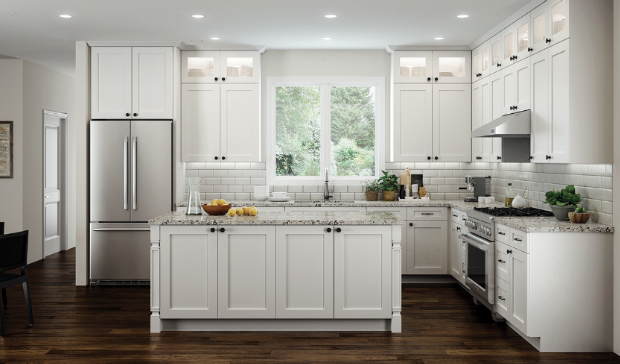Kitchen cabinets are the backbone of any kitchen design. They not only provide essential storage but also define the overall aesthetic and layout of the space. Whether you’re planning a full kitchen remodel or simply upgrading old fixtures, choosing the right cabinets is one of the most impactful decisions you can make.
In this article, we’ll explore the types, materials, styles, and features of modern kitchen cabinets — and how they can transform your kitchen into a space that’s both practical and beautiful.
Why Kitchen Cabinets Matter
More than just storage, kitchen cabinets influence:
- Organization: Cabinets keep cookware, utensils, and food neatly tucked away.
- Efficiency: A smart cabinet layout improves workflow during cooking and cleaning.
- Style: Cabinets dominate the visual space, so their design greatly impacts the room’s look and feel.
- Home Value: High-quality cabinetry can increase the resale value of your home.
From a design standpoint, they act as the anchor for countertops, backsplashes, appliances, and flooring.
Types of Kitchen Cabinets
Understanding the basic types of cabinets helps you choose the right mix for your kitchen layout:
1. Base Cabinets
These sit directly on the floor and support countertops. They house sinks, dishwashers, pull-out trash bins, and drawers. Their standard height is around 34.5 inches (with countertop), and they come in a range of widths.
2. Wall Cabinets
Also known as upper cabinets, they are mounted to the wall above countertops. They store dishes, glasses, and pantry items. Their height and depth can vary, especially in custom designs.
3. Tall Cabinets
Often referred to as pantry cabinets or utility cabinets, these run from floor to ceiling and are perfect for storing dry goods, cleaning supplies, or small appliances.
4. Specialty Cabinets
These include corner units, lazy Susans, spice pull-outs, wine racks, and appliance garages. They are designed to optimize difficult or overlooked areas.
Popular Cabinet Materials
The material you choose for your cabinets affects durability, appearance, and price.
Solid Wood
Strong, timeless, and available in various species like oak, maple, cherry, and walnut. It can be stained or painted but may expand or contract with humidity.
Plywood
A durable, high-end alternative to solid wood for cabinet boxes. It’s strong, resists warping, and holds screws well.
MDF (Medium-Density Fiberboard)
A smooth, stable material ideal for painted cabinets. It’s less expensive than wood but not as moisture-resistant.
Particleboard
A more affordable option, commonly found in stock cabinets. It’s lighter but also less durable and more prone to damage from moisture.
Laminate and Thermofoil
These are synthetic coatings applied over MDF or particleboard. They offer easy maintenance and a wide range of colors and finishes but can be prone to peeling over time.
Cabinet Door Styles
Your cabinet doors define the overall kitchen style. Here are the most common designs:
- Shaker: The most popular style today. Features a five-piece door with a recessed center panel. Simple and versatile.
- Flat-Panel (Slab): Sleek and modern, with a smooth, unembellished surface. Ideal for contemporary kitchens.
- Raised Panel: A traditional design with a raised center panel and detailed profiles.
- Glass-Front: Adds openness and is great for displaying dishes or glassware.
- Beadboard: Features vertical planks for a cozy, cottage-style look.
Finishes range from painted (white, navy, black, sage green) to stained wood tones, or high-gloss laminates for modern interiors.
Stock vs. Semi-Custom vs. Custom Cabinets
The level of customization you choose impacts both price and design flexibility.
Stock Cabinets
Pre-manufactured in standard sizes. The most affordable and readily available, but with limited options.
Semi-Custom Cabinets
Offer more flexibility in sizing, finishes, and features. A great balance of cost and customization.
Custom Cabinets
Built to your exact specifications. Ideal for unique layouts or specific design visions. Typically the most expensive option.
Smart Features and Accessories
Modern kitchen cabinets aren’t just boxes with doors. Consider upgrading with these functional features:
- Soft-close hinges and drawer glides for quiet use and longer life.
- Pull-out trays and shelves for easier access to deep spaces.
- Built-in dividers for cutlery, spices, or baking trays.
- Under-cabinet lighting to improve task lighting and ambiance.
- Vertical storage for cutting boards or baking sheets.
- Toe-kick drawers for hidden storage in the baseboard area.
These details greatly improve your kitchen’s usability and organization.
Tips for Choosing the Right Cabinets
- Consider Your Lifestyle – Do you cook daily? Have kids? Host guests often? Your habits should influence your cabinet layout and materials.
- Set a Realistic Budget – Cabinets can account for 30–40% of a kitchen remodel. Include costs for installation and hardware.
- Think Long-Term – Choose neutral colors and durable materials if you plan to live in your home for years, or want to appeal to future buyers.
- Work with Professionals – A designer or cabinet specialist can help you maximize space and avoid costly mistakes.
Conclusion
Kitchen cabinets are much more than storage — they are the foundation of both function and design in your kitchen. From materials and styles to layout and features, each choice contributes to the kitchen’s usability and aesthetic. Whether you opt for classic shaker cabinets or sleek, high-gloss finishes, well-designed cabinetry will ensure your kitchen looks beautiful and works efficiently for years to come.
